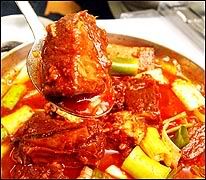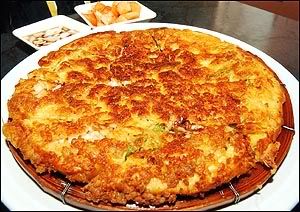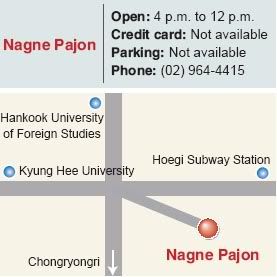Kkangjang at Kkangjang jip, Gwanghwamun behind the Sejong Center for the Performing Arts.
Lining Up for 'Kkangjang' Stew Is Definitely Worth the Wait
By Lee Yong-sung and Kim Hyun-cheol, Staff Reporters
The restaurant "Kkangjangjip", which opened back in 1986 as a tiny little Korean diner behind the Sejong Center for the Performing Arts, has grown to become one of the most crowded places during lunch hour in the entire city.
"Kkangjang", the most popular dish here, is only 4,500 won, yet the restaurant's owner has been named as one of the most successful non-franchise restaurant owners in the country, including being listed in a recent book about highly successful eating places in Korea.
The restaurant has been a success over the last 18 years since its opening. During that time, the ownership was transferred from original owner Lim Pil-soon to her son, Lee Kwang-jin. However, one very crucial thing has not changed at the restaurant, which explains the secret of its steady success: the taste.
Kkangjang is a shortened word for "kangtoenjang", which basically is nothing more than a strong-flavored and unprocessed "toenjang", or soybean paste. However, as it is, "kkang toenjang" is too thick and salty, so it is mixed with processed toenjang and half an onion to add sweetness and lessen the original salty taste, which creates mouth-watering kkangjang.
Other key ingredients are finely diced pork and squid, garlic and hot pepper. One key point is to cook over a high flame for a short time, according to Lee.
Kkangjang is served with a bowl of rice and a larger bowl containing lettuce, bean sprouts and leeks. There are surely as many ways to eat kkangjang as there are customers at Kkangjangjip, but the most common way is to pour the rice into the bowl with the vegetables and mix it with the kkangjang, much like eating "pibimbap". Don't forget to try the restaurant's special "yolmu mulkimchi" (water kimchi made of young radish). Its cool, fresh taste goes well with kkangjang.
Besides kkangjang, "kkongchi ttukbaegi" (spicy saury stew, 4,500 won) is another popular item on the menu, especially during winter. Despite being a fish stew, customers shouldn’t be dissuaded from trying it since it lacks an off-putting, fishy odor that other soups often have.
For drinkers, various other side dishes are also available, including "toenjang possam" (boiled and sliced pork served with cabbage leaves to wrap into bundles, 15,000 won), "haemul pajon" (seafood pancake, 10,000 won) and "nakji bokum" (hot, stir-fried baby octopus, 14,000 won).
An additional bowl of rice is served at no extra charge for every menu item. After the meal, coffee and green tea are also available for free.


Maeoon kalbijim at Ondoljip, Seocho-Dong near Yangjae subway station.
Extra-Hot Kalbijjim Will Take Your Tongue on an Adventure
By Kim Hyun-cheol, Lee Yong-sung, Staff Reporters
As you may already know, hot and spicy is not really a taste so much as a sense of pain. But enthusiasts will also acknowledge it is addictive; the pain makes them happy. And South Korea may have far more of these "dens of pain" than many other places on the globe.
When devouring the dishes, customers don't really look happy with their faces dripping in sweat and tongues hanging out from the excessive heat. However, somehow they keep coming back, as if magnetized to those spicy restaurants. If this is you, you’re probably already hooked on the hot taste.
Those regularly on the prowl for new spiciness will already be familiar with the name "Ondoljip" (House with stone-heated floor), a restaurant specializing in hot food, located in Seocho-Dong, Southern Seoul. Just two years old, and the place has already got a name among those who crave that particular taste.
Upon entering you will see messages from satisfied customers decorating the walls, most of them proclaiming how much they enjoyed this "specially hot" moment. A good prelude to a gourmet's adventure.
But, don't expect a vast menu - there is only one item, maewoon kalbijjim (hot and spicy beef rib stew, 12,000 won). But you can have it in three ways - maewoon (hot), aju maewoon (very hot) and mujinjang maewoon (extremely hot).
Most customers have maewoon or aju maewoon kalbijjim. It might sound weird but Lee Choon-poong, the restaurant's owner, says he tries to stop customers from ordering the "mujinjang maewoon" unless they're regulars because according to Lee it is "the hottest dish in South Korea".
A bowl of rice with bean-sprout soup will be served first, along with some simple side dishes. But you better not complain both rice and soup are cold, unlike in almost all other places. You will soon be thankful when the main dish of kalbijjim arrives in a steel pot, half-cooked in the kitchen.
The pungent steam from the boiling pot will assail your nostrils and if you're a peppery-taste maniac you won’t be able to help jiggling in anticipation, even just from smelling the delicious stew.
It is highly recommended you just have "maewoon" style at first, because once you take your first spoonful the hot burning sensation will hit you full in the mouth. To lovers of the flavor it wouldn't be a mere exaggeration to call it "a moment of catharsis".
Then the next move is clear. You will have to stop right there, or find yourself guzzling it as if there's no tomorrow. But no one there seems to stop eating.
The owner Lee said the secret of the dish's sauce is to use abundant vegetables with quality peppers for a natural flavor and use less garlic so it doesn't get overwhelmingly stimulating.
"Many people visit this restaurant after hearing about it by word of mouth and I'm sure our dishes will satisfy them as long as they love the hot taste" Lee says.


Pajeon at Nagne Pajon, in the vicinity of Kyung Hee University and Hankook University of Foreign Studies, near Hoegi Subway Station.
Hoegi Subway Station Boasts the Best Pajon Restaurants Around
By Lee Yong-sung, Staff Reporter
Up until now, the most common translation for "pajon" in English has been Korean pancake. However, I you've ever been to any of the pajon restaurants clustered near Hoegi subway station in northeastern Seoul, you would have recognized almost immediately that the word choice was not right at all.
First of all, pajon served in the unique, more than 30 year old college town restaurant district is as large and thick as regular pizza (not typically thin Italian pizza, but closer to American pan pizza). What makes the translation most inappropriate though, is not its size alone.
Different from the pancakes most frequently found on North American breakfast tables, in a whole round piece of pajon, sea food like squid, shrimp and oyster, along with Welsh onion ("pa" in Korean) are abundantly used, all mixed together and then cooked in a frypan.
Then what should we call this unique Korean dish in English? Considering its size and the variety of ingredients, pizza seems to be the only candidate that barely comes close to pajon, but in fact, that’s basically all they have in common. So why can't we just call pajon "pajon" in English? As it is, in every way a uniquely Korean dish, like kimchi.
Among some ten pajon restaurants near the subway station, the oldest is "Nagne (meaning wanderer in Korean) Pajon". Opened 34 years ago, the diner has made special moments of poor college students even more special, with big, extraordinarily cheap and delicious seafood pajon.
Pleasing the taste buds of students from nearby Kyung Hee University and Hankook University of Foreign Studies, the Nagne Pajon now has three more branch restaurants near Hanyang and Korea University respectively, and two overseas branches in China. "Those who customized our restaurant 20 years ago as students now bring their children," Kong Kyung-ja, the owner of the diner said to The Korea Times. Opening the store right after her late husband’s company went out of business, Kong offers a pan of pajon a thousand won cheaper (6,000 won) at the main store, in appreciation of those loyal customers.
One of the key ingredients in its long-loved pajon is egg. Once cooked, the mixture of seafood, ground pork and Welsh onion is refried, covered with beaten egg. The use of egg not only adds extra nutritional value to the pajon, but also pleasant crispness to the texture.
Besides the all-time popular regular seafood pajon, "oyster pajon (10,000 won)" and "tonggurang ttaeng (small Korean meatball dish, 6,000 won)" are also recommended. A regular pan of pajon is big enough for three hungry mouths at dinnertime. So don't order too much just because it's cheap! One last thought: Pajon is excellent accompanied by makgoli (traditional Korean rice wine, 4,000 won/bottle). Have a good time!


No comments:
Post a Comment